tow Citroen C5 2016 (RD/TD) / 2.G Owner's Manual
[x] Cancel search | Manufacturer: CITROEN, Model Year: 2016, Model line: C5, Model: Citroen C5 2016 (RD/TD) / 2.GPages: 366, PDF Size: 30.93 MB
Page 5 of 366
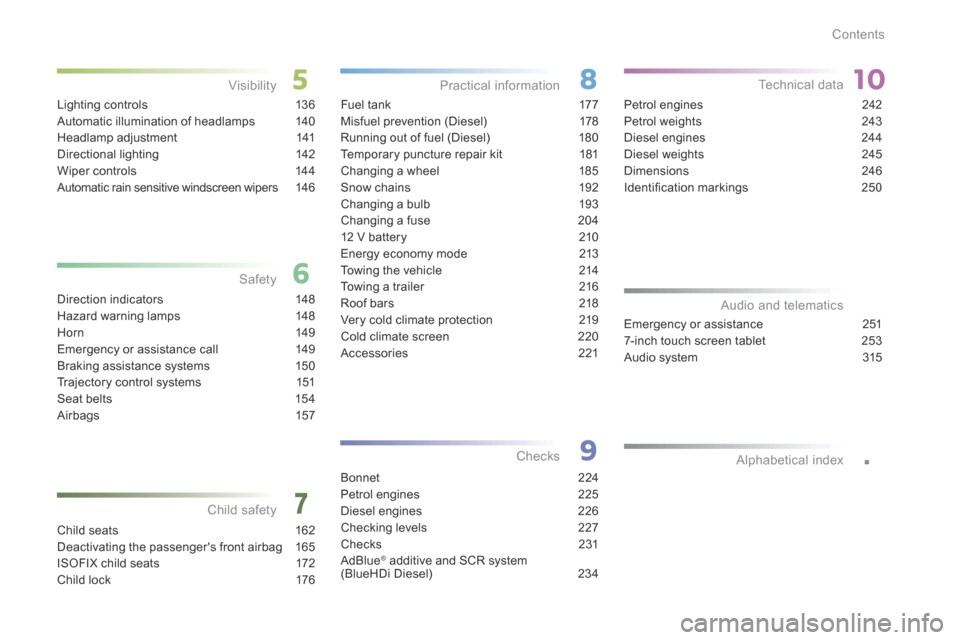
.
C5_en_Chap00a_sommaire_ed01-2015
Direction indicators 148
Hazard warning lamps 148
Hor n 149
Emergency or assistance call 149
Braking assistance systems 150
Trajectory control systems 151
Seat belts 154
Airbags 157Fuel tank
177
Misfuel prevention (Diesel) 178
Running out of fuel (Diesel) 180
Temporary puncture repair kit 181
Changing a wheel 185
Snow chains 192
Changing a bulb 193
Changing a fuse 204
12 V battery 210
Energy economy mode 213
Towing the vehicle 214
Towing a trailer 216
Roof bars 218
Very cold climate protection 219
Cold climate screen 220
a ccessories 221
Bonnet 224
Petrol engines 225
Diesel engines 226
Checking levels 227
Checks 231
ad blue
® additive and SCR system
(BlueHDi Diesel) 234Petrol engines
242
Petrol weights 243
Diesel engines 244
Diesel weights 245
Dimensions 246
Identification markings 250
Emergency or assistance 251
7-inch touch screen tablet 253
Audio system 315
Audio and telematics
Lighting controls 136
Automatic illumination of headlamps 140
Headlamp adjustment 141
Directional lighting 142
Wiper controls 144
Automatic rain sensitive windscreen wipers 14 6
Alphabetical index
Child safety Practical information
Checks
Visibility
Safety Technical data
Child seats
162
Deactivating the passenger's front airbag 165
ISOFIX child seats 172
Child lock 176
Contents
Page 6 of 366
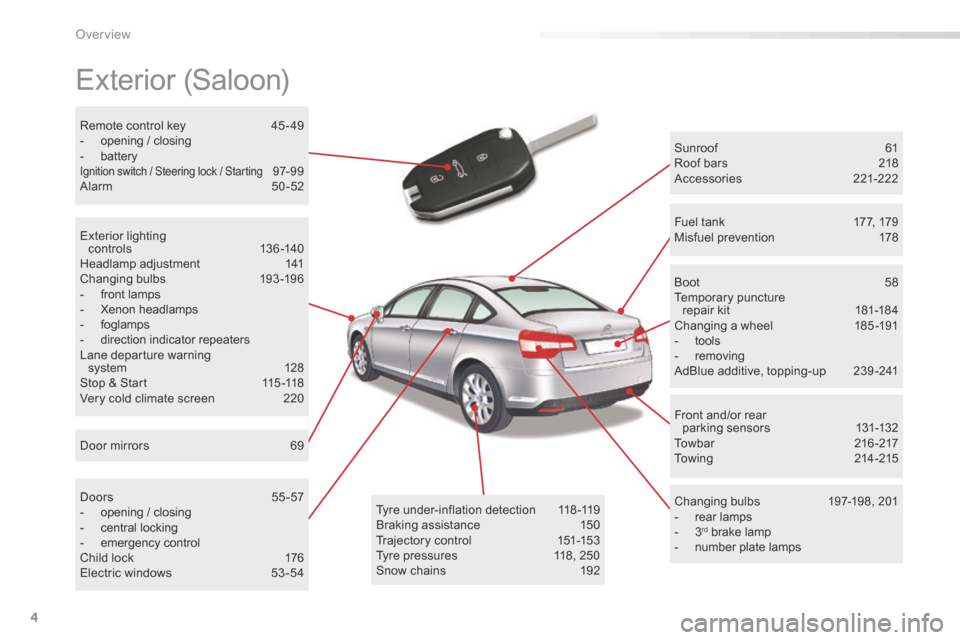
4
C5_en_Chap00b_vue-ensemble_ed01-2015
Exterior (Saloon)
Sunroof 61
Roof bars 218
a ccessories 221-222
Changing bulbs 197-198, 201
- rear lamps
- 3
rd brake lamp
- number plate lamps
Boot
58
Temporary puncture
repair kit 181-184
Changing a wheel 185 -191
- tools
- removing
AdBlue additive, topping-up 239 -241
Tyre under-inflation detection 118 -119
Braking assistance 150
Trajectory control 151-153
Tyre pressures 118, 250
Snow chains 192Fuel tank
177, 179
Misfuel prevention 178
Remote control key
45 - 49
- opening / closing
- battery
Ignition switch / Steering lock / Starting 97- 9 9
Alarm 50-52
Door mirrors 69
Exterior lighting
c o nt r o ls 13 6 -14 0
Headlamp adjustment 141
Changing bulbs 193-196
- front lamps
- Xenon headlamps
- foglamps
- direction indicator repeaters
Lane departure warning system 128
Stop & Start 115 -118
Very cold climate screen 220
Doors 55 -57
- opening / closing
- central locking
- emergency control
Child lock 176
Electric windows 53 -54 Front and/or rear
parking sensors 131-132
Towbar 216 -217
Towing 214 -215
over view
Page 7 of 366
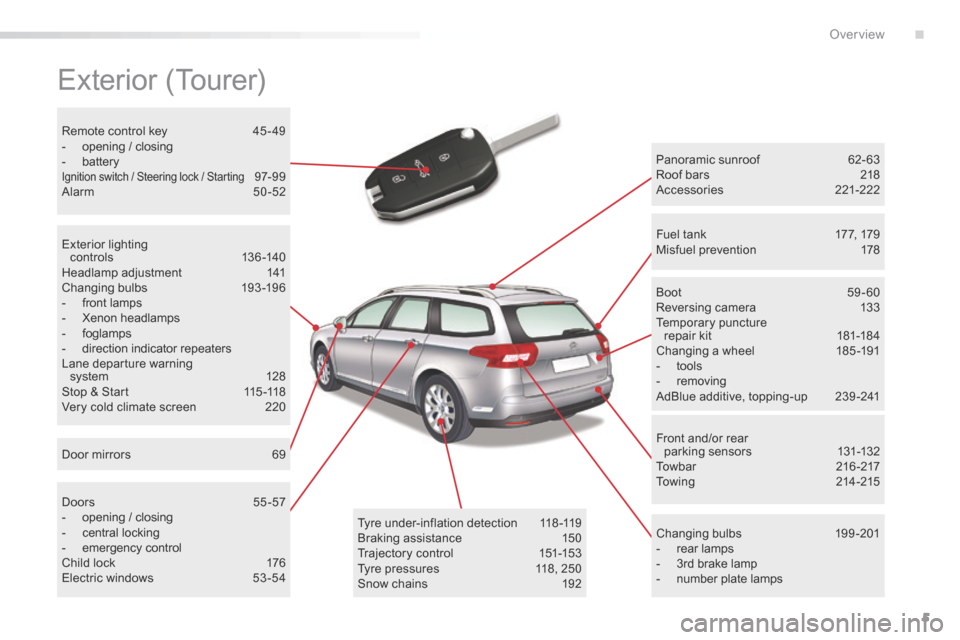
5
C5_en_Chap00b_vue-ensemble_ed01-2015
Exterior (Tourer)
Panoramic sunroof 62- 63
Roof bars 218
a ccessories 221-222
Changing bulbs 199-201
- rear lamps
- 3rd brake lamp
- number plate lamps
Boot
59-60
Reversing camera 133
Temporary puncture
repair kit 181-184
Changing a wheel 185 -191
- tools
- removing
AdBlue additive, topping-up 239 -241
Tyre under-inflation detection 118 -119
Braking assistance 150
Trajectory control 151-153
Tyre pressures 118, 250
Snow chains 192
Remote control key
45 - 49
- opening / closing
- battery
Ignition switch / Steering lock / Starting 97- 9 9
Alarm 50-52
Fuel tank 177, 179
Misfuel prevention 178
Door mirrors 69
Exterior lighting
c o nt r o ls 13 6 -14 0
Headlamp adjustment 141
Changing bulbs 193-196
- front lamps
- Xenon headlamps
- foglamps
- direction indicator repeaters
Lane departure warning system 128
Stop & Start 115 -118
Very cold climate screen 220
Doors 55 -57
- opening / closing
- central locking
- emergency control
Child lock 176
Electric windows 53 -54 Front and/or rear
parking sensors 131-132
Towbar 216 -217
Towing 214 -215
.
over view
Page 8 of 366
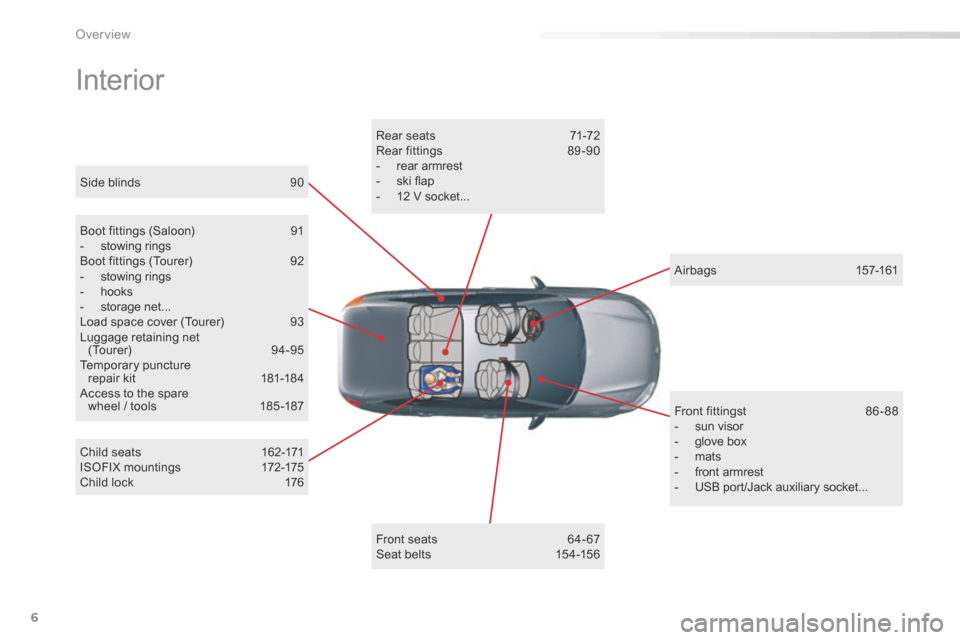
6
C5_en_Chap00b_vue-ensemble_ed01-2015
Interior
Boot fittings (Saloon) 91
- stowing rings
Boot fittings (Tourer) 92
- stowing rings
- hooks
- storage net...
Load space cover (Tourer) 93
Luggage retaining net (Tourer) 94-95
Temporary puncture
repair kit 181-184
a ccess to the spare
wheel / tools 185 -187
Child seats 162-171
ISOFIX mountings 172-175
Child lock 176Rear seats
71-72
Rear fittings 89 -90
- rear armrest
- ski flap
- 12 V socket...
Front seats 64- 67
Seat belts 154-156Airbags
157-161
Side blinds
90
Front fittingst 86 - 88
- sun visor
- glove box
- mats
- front armrest
- USB port/Jack auxiliary socket...
over view
Page 14 of 366
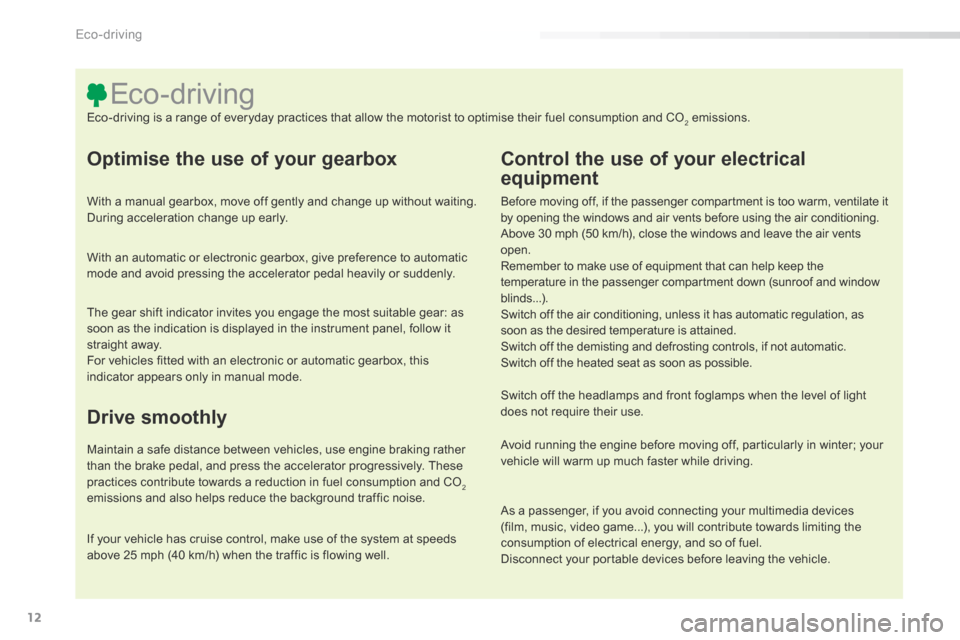
12
C5_en_Chap00c_eco-conduite_ed01-2015
Optimise the use of your gearbox
With a manual gearbox, move off gently and change up without waiting.
During acceleration change up early.
With an automatic or electronic gearbox, give preference to automatic
mode and avoid pressing the accelerator pedal heavily or suddenly.
Control the use of your electrical
equipment
Before moving off, if the passenger compartment is too warm, ventilate it
by opening the windows and air vents before using the air conditioning.
Above 30 mph (50 km/h), close the windows and leave the air vents
open.
Remember to make use of equipment that can help keep the
temperature in the passenger compartment down (sunroof and window
blinds...).
Switch off the air conditioning, unless it has automatic regulation, as
soon as the desired temperature is attained.
Switch off the demisting and defrosting controls, if not automatic.
Switch off the heated seat as soon as possible.
Switch off the headlamps and front foglamps when the level of light
does not require their use.
Avoid running the engine before moving off, particularly in winter; your
vehicle will warm up much faster while driving.
As a passenger, if you avoid connecting your multimedia devices
(film, music, video game...), you will contribute towards limiting the
consumption of electrical energy, and so of fuel.
Disconnect your portable devices before leaving the vehicle.
Eco-driving
Eco-driving is a range of everyday practices that allow the motorist to optimise their fuel consumption and CO2 emissions.
The gear shift indicator invites you engage the most suitable gear: as
soon as the indication is displayed in the instrument panel, follow it
straight away.
For vehicles fitted with an electronic or automatic gearbox, this
indicator appears only in manual mode.
Drive smoothly
Maintain a safe distance between vehicles, use engine braking rather
than the brake pedal, and press the accelerator progressively. These
practices contribute towards a reduction in fuel consumption and CO
2
emissions and also helps reduce the background traffic noise.
If your vehicle has cruise control, make use of the system at speeds
above 25 mph (40 km/h) when the traffic is flowing well.
Eco-driving
Page 36 of 366
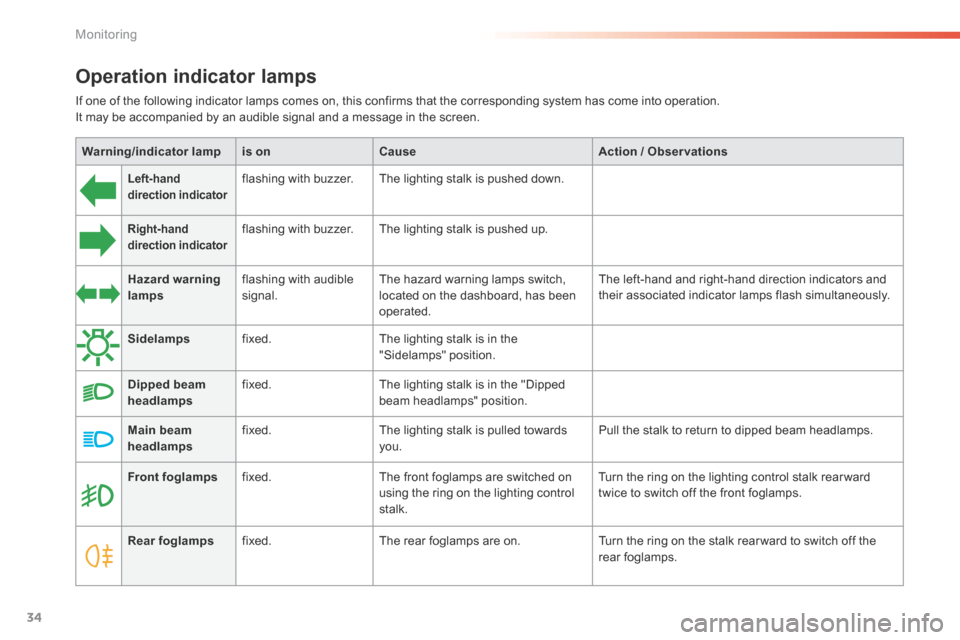
34
C5_en_Chap01_controle-de-marche_ed01-2015
Front foglampsfixed. The front foglamps are switched on
using the ring on the lighting control
stalk. Turn the ring on the lighting control stalk rear ward
twice to switch off the front foglamps.
Rear foglamps fixed. The rear foglamps are on. Turn the ring on the stalk rear ward to switch off the
rear foglamps.
Operation indicator lamps
Warning/indicator lampis on Cause Action / Observations
Left-hand
direction indicatorflashing with buzzer. The lighting stalk is pushed down.
Right-hand
direction indicatorflashing with buzzer.The lighting stalk is pushed up.
Sidelamps fixed. The lighting stalk is in the
"Sidelamps" position.
Dipped beam
headlamps fixed.
The lighting stalk is in the "Dipped
beam headlamps" position.
Main beam
headlamps fixed.
The lighting stalk is pulled towards
you. Pull the stalk to return to dipped beam headlamps.
Hazard warning
lamps
flashing with audible
signal. The hazard warning lamps switch,
located on the dashboard, has been
operated. The left-hand and right-hand direction indicators and
their associated indicator lamps flash simultaneously.
If one of the following indicator lamps comes on, this confirms that the corresponding system has come into operation.
It may be accompanied by an audible signal and a message in the screen.
Monitoring
Page 47 of 366
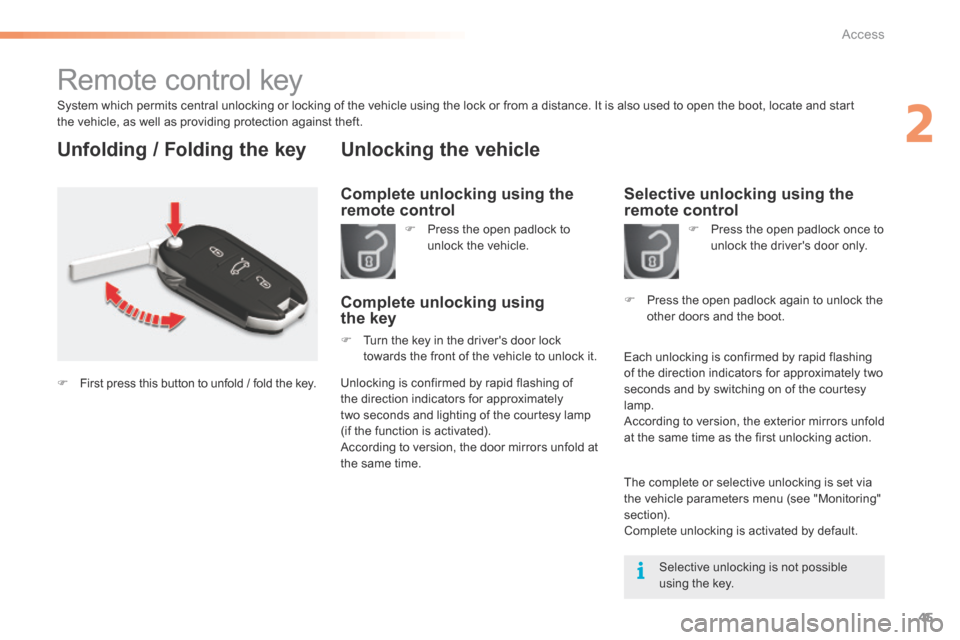
45
C5_en_Chap02_ouverture_ed01-2015
Remote control key
System which permits central unlocking or locking of the vehicle using the lock or from a distance. It is also used to open the boot, locate and start
the vehicle, as well as providing protection against theft.
Unfolding / Folding the key
Complete unlocking using the
remote control
Unlocking the vehicle
F Press the open padlock to
unlock the vehicle.
Complete unlocking using
the key
F Turn the key in the driver's door lock
towards the front of the vehicle to unlock it.
Selective unlocking using the
remote control
F Press the open padlock once to
unlock the driver's door only.
Each unlocking is confirmed by rapid flashing
of the direction indicators for approximately two
seconds and by switching on of the courtesy
lamp.
According to version, the exterior mirrors unfold
at the same time as the first unlocking action. F
Press the open padlock again to unlock the
other doors and the boot.
Selective unlocking is not possible
using the key.
Unlocking is confirmed by rapid flashing of
the direction indicators for approximately
two seconds and lighting of the courtesy lamp
(if the function is activated).
According to version, the door mirrors unfold at
the same time.
F
First press this button to unfold / fold the key.
The complete or selective unlocking is set via
the vehicle parameters menu (see "Monitoring"
section).
Complete unlocking is activated by default.
2
access
Page 48 of 366
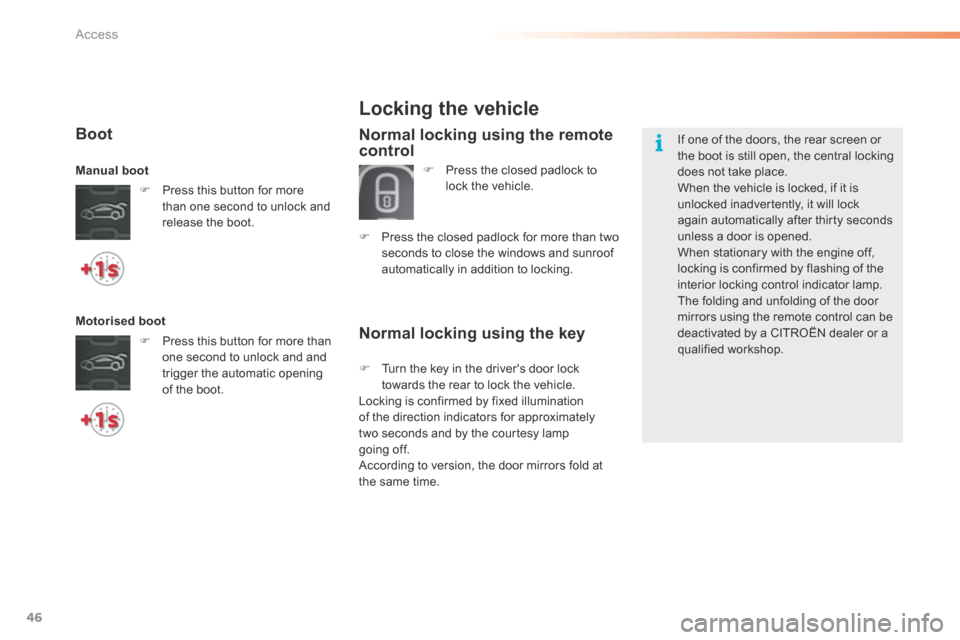
46
C5_en_Chap02_ouverture_ed01-2015
Normal locking using the key
Locking the vehicle
Normal locking using the remote
control
F Press the closed padlock to
lock the vehicle.
F Press the closed padlock for more than two
seconds to close the windows and sunroof
automatically in addition to locking. If one of the doors, the rear screen or
the boot is still open, the central locking
does not take place.
When the vehicle is locked, if it is
unlocked inadvertently, it will lock
again automatically after thirty seconds
unless a door is opened.
When stationary with the engine off,
locking is confirmed by flashing of the
interior locking control indicator lamp.
The folding and unfolding of the door
mirrors using the remote control can be
deactivated by a CITR
oËn dealer or a
qualified workshop.
F Turn the key in the driver's door lock
towards the rear to lock the vehicle.
Locking is confirmed by fixed illumination
of the direction indicators for approximately
two seconds and by the courtesy lamp
going off.
According to version, the door mirrors fold at
the same time.
Boot
F Press this button for more
than one second to unlock and
release the boot.
Manual
boot
Motorised boot
F Press this button for more than
one second to unlock and and
trigger the automatic opening
of the boot.
access
Page 53 of 366
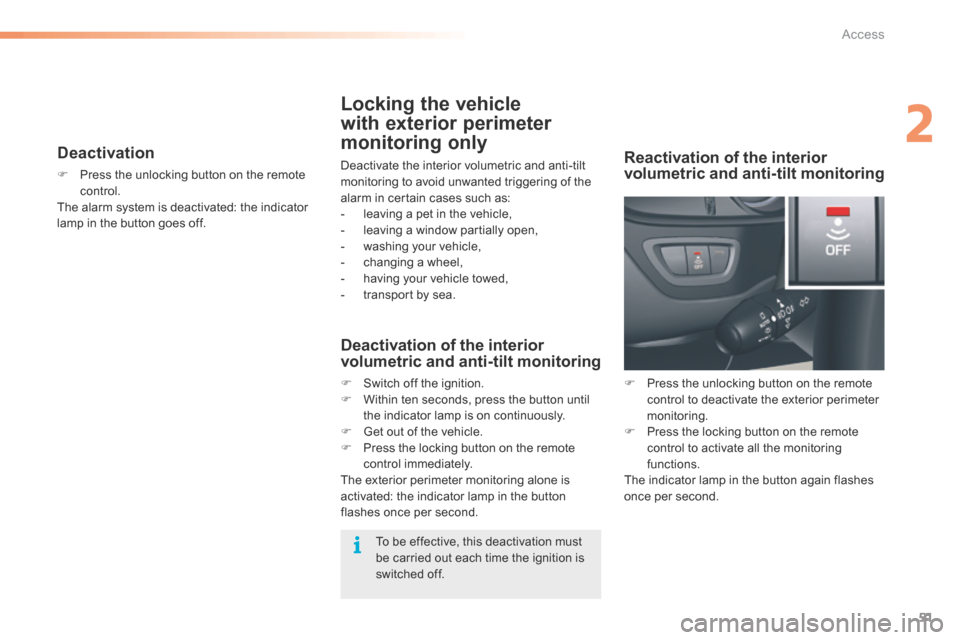
51
C5_en_Chap02_ouverture_ed01-2015
Deactivation
F Press the unlocking button on the remote
control.
The alarm system is deactivated: the indicator
lamp in the button goes off.
Locking the vehicle
with exterior perimeter
monitoring only
Deactivate the interior volumetric and anti-tilt
monitoring to avoid unwanted triggering of the
alarm in certain cases such as:
- leaving a pet in the vehicle,
- leaving a window partially open,
- washing your vehicle,
- changing a wheel,
- having your vehicle towed,
- transport by sea.
Deactivation of the interior
volumetric and anti-tilt monitoring
F Switch off the ignition.
F Within ten seconds, press the button until
the indicator lamp is on continuously.
F Get out of the vehicle.
F Press the locking button on the remote
control immediately.
The exterior perimeter monitoring alone is
activated: the indicator lamp in the button
flashes once per second.
Reactivation of the interior
volumetric and anti-tilt monitoring
F Press the unlocking button on the remote
control to deactivate the exterior perimeter
monitoring.
F Press the locking button on the remote
control to activate all the monitoring
functions.
The indicator lamp in the button again flashes
once per second.
To be effective, this deactivation must
be carried out each time the ignition is
switched off.
2
access
Page 59 of 366
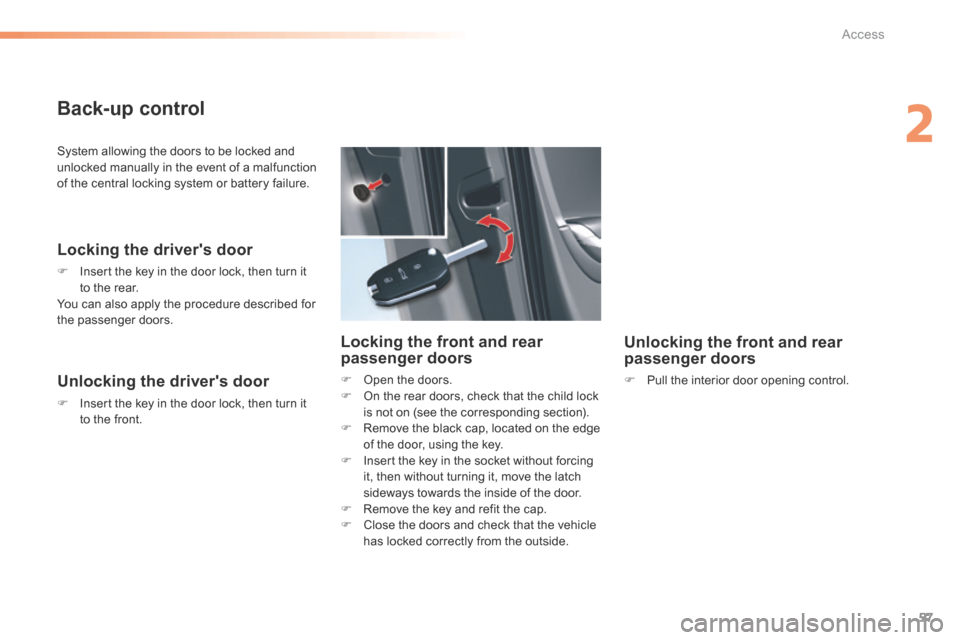
57
C5_en_Chap02_ouverture_ed01-2015
System allowing the doors to be locked and
unlocked manually in the event of a malfunction
of the central locking system or battery failure.
Locking the driver's door
F Insert the key in the door lock, then turn it
to the rear.
You can also apply the procedure described for
the passenger doors.
Unlocking the driver's door
F Insert the key in the door lock, then turn it
to the front.
Locking the front and rear
passenger doors
F Open the doors.
F On the rear doors, check that the child lock
is not on (see the corresponding section).
F Remove the black cap, located on the edge
of the door, using the key.
F Insert the key in the socket without forcing
it, then without turning it, move the latch
sideways towards the inside of the door.
F Remove the key and refit the cap.
F Close the doors and check that the vehicle
has locked correctly from the outside.
Unlocking the front and rear
passenger doors
F Pull the interior door opening control.
Back-up control
2
access